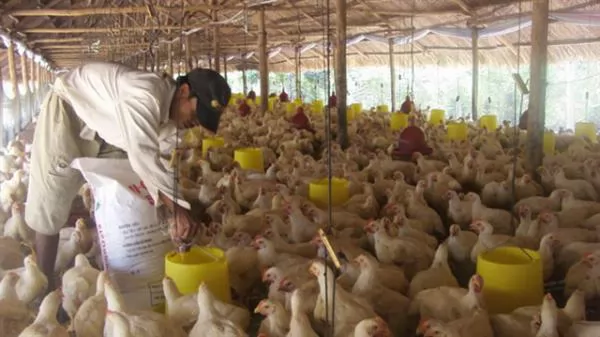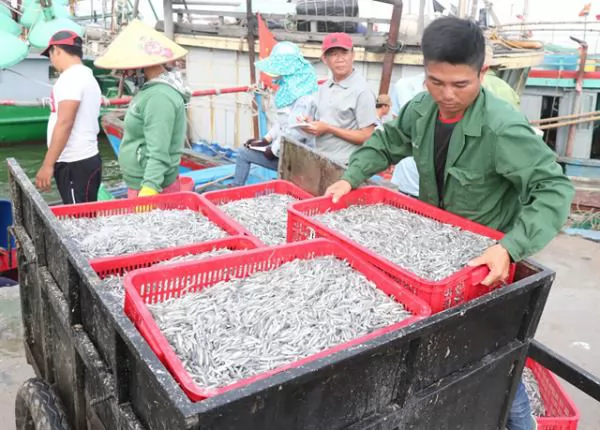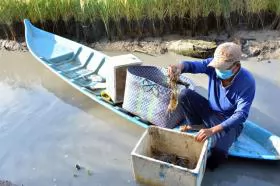Cà Mau focuses on clean agricultural products

A shrimp pond in Cà Mau Province where advanced farming techniques are used. VNA/VNS Photo
Cà Mau Province has expanded its area under the shrimp – forest and shrimp – rice models to farm clean products for export and ensure farmers earn sustainable incomes.
CÀ MAU – Cà Mau Province has expanded its area under the shrimp – forest and shrimp – rice models to farm clean products for export and ensure farmers earn sustainable incomes.
The southernmost province has developed models that use advanced farming techniques and increase co-operation among stakeholders in production and consumption.
In recent years its agriculture has adapted to market requirements, thus increasing the value of its products.
Many local shrimp processing companies have signed contracts to develop value chains with co-operative teams and co-operatives with a total of 3,500 household members.
They supply raw materials and teach the households techniques for farming shrimp, and buy their shrimp for processing.
This also helps the households develop certified shrimp farming areas.
The province People’s Committee has allowed the Minh Phú Seafood Corporation and Lộc Trời Group to tie up with Thới Bình District and other localities to pilot a link-up between companies and farmers adopting the shrimp-rice model.
Thới Bình has 18,500ha under the model, the largest area in the province.
Farmers there breed black tiger shrimp or white-legged shrimp in the dry season and grow rice in the rainy season on the same fields.
Many have also been intercropping giant river prawns and rice for almost five years now.
To improve the efficiency of the model, district authorities have trained thousands of farmers in it since 2020.
The rice varieties, which include ST 25 and ST 24, winners of awards as the world’s best, have short maturity periods and can resist saltwater and drought.
Trần Năm, who farms shrimp in a mangrove forest locally, said in the past, he had not been aware of the advantages of breeding shrimp in mangrove forests and paid little attention to the model, and so the creatures on his farm were often affected by diseases.
“Shrimp bred under the shrimp-forest farming model has few disease threats and offers high and steady incomes.”
His family has been earning nearly VNĐ200 million (US$8,000) a year in recent years after adopting the model.
Shrimp farmed in mangrove forests can be harvested in four months.
Nguyễn Văn Phúc, head of the Thới Bình District Department of Agriculture and Rural Development, said the effectiveness of the rice-shrimp model was increasing by the year, with the average yield of the grain rising from 3.8 tonnes per hectare in 2013 to 4.8 tonnes in 2021.
The black tiger shrimp yield has doubled since switching from the traditional model to 320kg per hectare.
Besides shrimp, farmers also breed creatures like mud crabs and fish in mangrove forests.
The province has also developed co-operation chains for other agricultural products such as clean high-yield rice in Trần Văn Thời District, speciality rice and shrimp farmed alternately in paddies in Thới Bình District and vegetables in Cà Mau City’s Lý Văn Lâm Commune.
Many co-operation chain models have proven successful in recent years, helping shift agriculture towards commercial production and exploiting the advantages of each locality. – VNS
Maybe you are interested

Poultry breeders suffer losses due to oversupply
ĐỒNG NAI — The oversupply of poultry has led to high costs and low selling prices, causing losses for breeders nationwide, especially in Đồng Nai Province, the leading area for battery chicken production.

Mekong Delta to expand shrimp - rice farming model
HCM CITY — The shrimp - rice farming model in the Cửu Long (Mekong) Delta will offer farmers greater benefits when all related stakeholders work together to improve its value and protect the environment...

Protecting raw resources vital to the future of fish sauce
HÀ NỘI — Fish sauce is a staple found on tables up and down the country - in fact, the General Statistics Office (GSO) reported last year that the average person consumed 3.9 litres of fish sauce annually.





